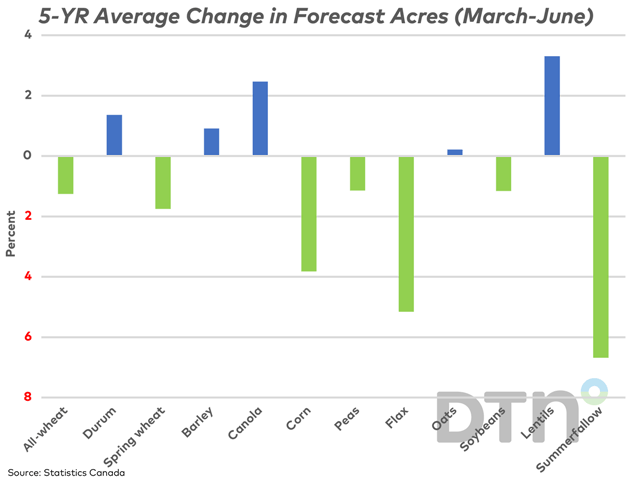Canada Markets
Average March Intentions to June Acreage Change
Statistics Canada will be releasing updated acreage estimates early on June 28.
A poll of industry participants by MarketsFarm found on the DTN Canada site would indicate only minor tweaking of the original estimates released on April 26 is expected this month.
This report may be a test of Statistics Canada's revised methodology for gathering data for the early report. The initial report has long been referred to as the March intentions report. For example, in 2022 the survey was conducted between March 1 and March 29, as it has been conducted in the past. In 2023, a revised methodology saw the survey conducted between December 12, 2022, and January 14, 2023. Wednesday's report may signal whether this was too early to survey producers, with changing weather, markets, seed availability and a lack of crop insurance coverage levels just some of the factors that could lead to changes in intentions.
Another factor pointed out following the initial data release is that roughly 2,000 fewer producers were surveyed in 2023 when compared to recent years.
The attached chart shows the five-year average percent change in acres from the March intentions report to the second acreage report released in June. Over the past five years, the acreage for durum, barley, canola, oats and lentils have shown a tendency to be revised higher in the second report. Of these crops, the most consistent result is seen for canola where acres were revised higher in four of five years, with the maximum increase of 6.3% and the average increase of 2.5%.
The green bars represent crops where the acreage was revised lower from the first report to the second report on average over the past five years. The most consistent result is seen for corn, which was revised lower in each of the past five years, averaging a 3.8% drop. Estimated acres for dry peas, flax and soybean acres were revised lower in four of five years.
Cliff Jamieson can be reached at cliff.jamieson@dtn.com
Follow him on Twitter @Cliff Jamieson
(c) Copyright 2023 DTN, LLC. All rights reserved.
P[L1] D[0x0] M[300x250] OOP[F] ADUNIT[] T[]






Comments
To comment, please Log In or Join our Community .